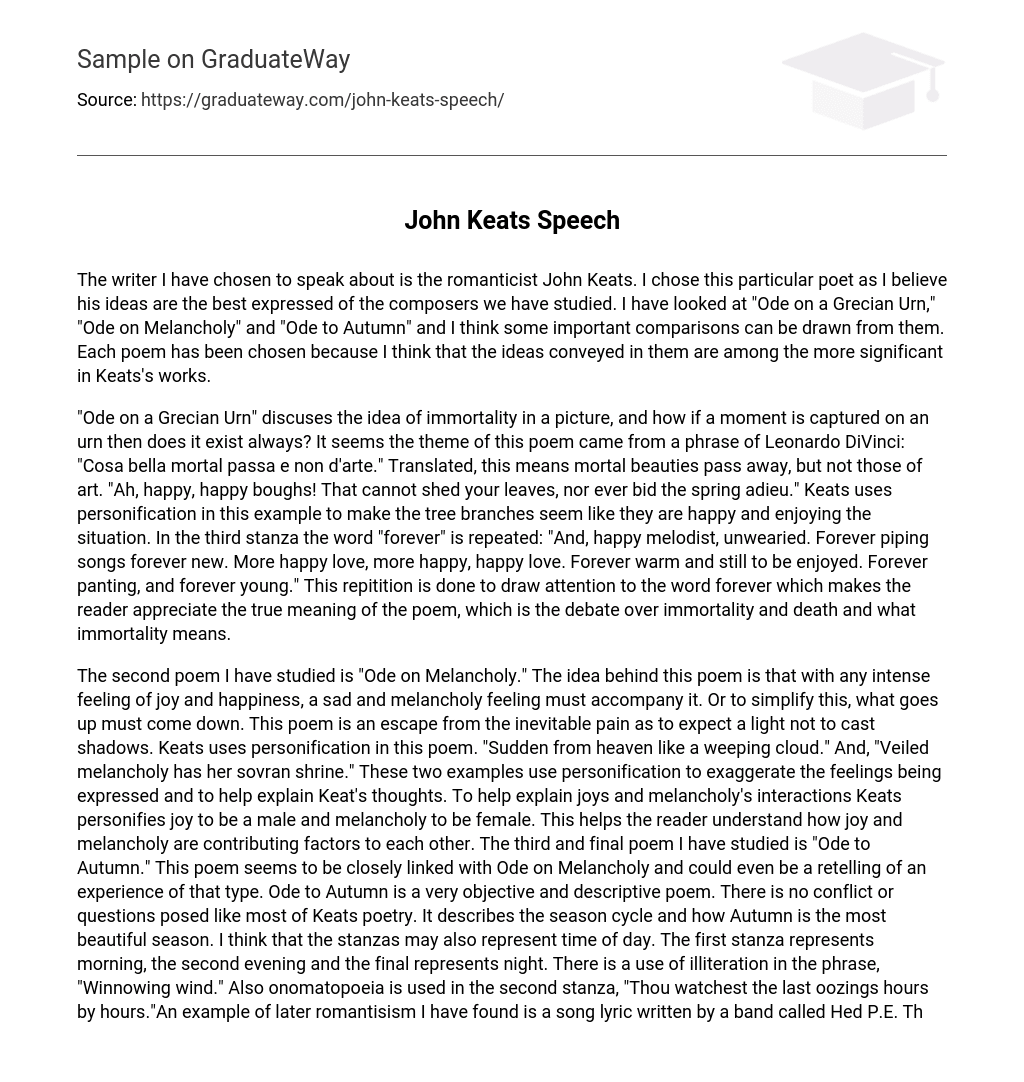The writer I have chosen to discuss is John Keats, a romanticist. Out of all the composers we have analyzed, I believe his ideas are the most effectively conveyed. Specifically, I have examined “Ode on a Grecian Urn,” “Ode on Melancholy,” and “Ode to Autumn.” Comparisons can be made between these poems as they contain important ideas that are significant in Keats’s body of work.
The poem “Ode on a Grecian Urn” explores the concept of immortality through the depiction of a picture, posing the question of whether a captured moment on an urn exists eternally. The inspiration for this theme is believed to have originated from Leonardo Da Vinci’s phrase: “Cosa bella mortal passa e non d’arte” which translates to mortal beauties pass away, but not those created through art. One instance of personification used by Keats is found in the line, “Ah, happy, happy boughs! That cannot shed your leaves, nor ever bid the spring adieu.” This portrays the tree branches as content and enjoying their situation. The third stanza highlights the repetition of the word “forever,” emphasizing the eternal nature of various elements: “And, happy melodist, unwearied. Forever piping songs forever new. More happy love, more happy, happy love. Forever warm and still to be enjoyed. Forever panting, and forever young.” This repetition aims to draw attention to the significance of the word forever, causing readers to contemplate the true meaning of the poem – the philosophical pondering of immortality and death, and what it truly entails.
The poem “Ode on Melancholy” explores the concept that intense feelings of joy and happiness are always accompanied by a sense of sadness and melancholy. The idea is simplified as “what goes up must come down.” The poem serves as a means of seeking refuge from the inevitable pain, as it is unrealistic to expect light without shadows. Keats uses personification in two instances to emphasize and explain his thoughts on these conflicting emotions. For example, he describes melancholy as a female with her sovereign shrine, and joy as a male. This personification helps readers understand how joy and melancholy contribute to each other.
In contrast, the poem “Ode to Autumn” appears to be closely linked to “Ode on Melancholy” and may even be a retelling of a similar experience. It is an objective and descriptive poem that does not present any conflicts or pose questions like most of Keats’ other poetry. Instead, it describes the cycle of seasons and highlights the beauty of autumn. It is possible that each stanza represents a different time of day, with the first stanza symbolizing morning, the second evening, and the final stanza representing nightfall.The utilization of illiteration is evident in the phrase “Winnowing wind.” Similarly, onomatopoeia is employed in the second stanza: “Thou watchest the last oozings hours by hours.” An illustration of later romanticism can be found in a song lyric composed by a band known as Hed P.E. The song, titled “Jesus of Nazareth,” revolves around a man’s struggles with his faith. The lyric primarily focuses on his battle against addictions (“I just don’t know when to quit”) and his plea for assistance from God to “make everything alright.” Feeling unsure and lost, he expresses fear towards the crucifix hanging on his wall, which symbolizes his doubts about religion and where to seek guidance. Another instance of modern romanticism is also found in a lyric by Hed P.E., this time in a song called “The Meadow.” This composition falls under romanticism as it explores a spiritual sanctuary one can retreat to, seeking an escape from reality and conversing with God.
Keats’s poems exhibit an overall aesthetic perspective on the world, exploring beauty and joy while acknowledging the pain of its eventual absence. These odes lack a definitive conclusion or synthesis, making them resist categorization as philosophical works. Some of Keats’s odes share connections and even continue from one another. Keats’s value as a writer lies in the relatability of his poetry, offering insights into common emotions and thoughts. As a romanticist, Keats’s poetry centers around nature, the human soul, and the human mind, often referencing god and religion.
Bibliography:





